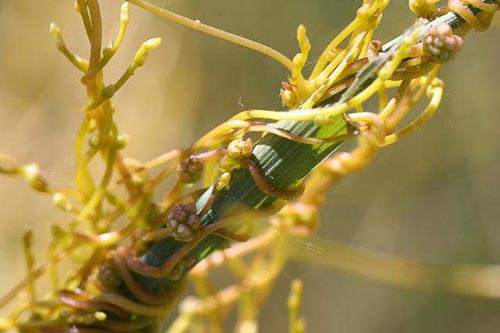Weeds
Cuscuta epilinum Weihe. - Flax Dodder
Systematic position.
Family Cuscutaceae Dumort., genus Cuscuta L.Biological group.
Annual stem parasitic plant.Morphology and biology.
C. epilinum plant has no normal roots and leaves, its stems twine around host plants, attaching to them by gaustoria. Stems are yellow-green, thread-like, slightly branched, 1.5 mm in diameter. Flowers are sessile, yellowish-white, aggregated by 5-15 into dense glomes. Calyx is hemispherical, deeply incised into widely ovate pointed lobes being nearly as long as corolla. Corolla is urceolate; its triangular, straight and pointed lobes are twice shorter than calyx tube. Stamens are located on short staminal threads, non- protruding from the flower. Long-fimbriate or bifid scales are attached to the base of calyx tube. Fruit is a compressed globular boll, with a deep aperture between pistil styles. Seeds are irregular-ovate, ovate or nearly oval, coarsely scrobiculate; often accrete by two, their color varies from yellowish-grey to dark-grey. This plant flowers in June-July, bears fruits in July-August. Maximum productivity is 4000 seeds. Seeds (even unripe) germinate in either autumn or spring. Optimum temperature for seed germination is 20-23°C, the germination starts on 3rd-4th day. Seed viability keeps up to 5-6 years; in soil, 8 months at most. Seedlings are able to live without host plant up to 20 days, reaching 8 cm in length.Distribution.
Europe, Eastern Asia and Asia Minor, North America, North Africa. Within the Former Soviet Union the plant occurs in central and south-western regions of the European part; being sporadically distributed in Western and Eastern Siberia, and in the Far East.Ecology.
This is a fast growing plant; one individual of C. epilinum can infest up to 120 flax plants, and the speed of infesting new plants is faster if the flax is still in succulent state. C. epilinum is a light-requiring plant; while flowering, the majority of its stems with flowers is situated in the upper part of flax stems, causing flax lodging; ripening, the seeds of C. epilinum hardly shatter and practically completely get into flax yield.Economic significance.
C. epilinum is a specialized weed of long-fibred flax, accompanying this crop in all regions of its growing. This weed also infests crown flax, though not everywhere, and parasitizes on the specific weeds of flax crops, Camelina sativa and Spergula linicola. It occasionally infests hemp, clover, beetroot and alfalfa. After seed ripening C. epilinum dies, even if the flax is still vegetating. Infested by the flax dodder plants decrease their weight, as well as stem length and width; fiber content falls; stock yield is reduced by 20-30%; and seed yield drops down sometimes by 70%. Control measures include cleaning of crop seeds with the use of trieurs, fertilizing with decomposed manure, crop rotation with cereal crops, mowing of the infested plants along with their subsequent drying, removing from the field, and burning.Reference citations:
Keller B.A., ed. 1934. Weed plants of the USSR. V.3. Leningrad: AN SSSR. 448 p. (in Russian).Maryushkina V.Ya., Didyk L.G., Kozeko V.G. & Kayutkina T.M. 1990. Manual on quarantine weeds. Kiev: Urozhai. 96 p. (in Russian).
Moskalenko G.P. 2001. Quarantine weeds of Russia. Moscow: Rosgoskarantin. 280 pp. (in Russian).
Nikitin V.V. 1983. Weed plants of the USSR flora. Leningrad: Nauka. 454 p. (in Russian).
Shishkin B.K., ed. 1953. Flora of the USSR. V.19. Moscow-Leningrad: AN SSSR. 752 p. (in Russian).
Volkov A.N., ed. 1935. Areas of distribution of the major weed plants in the USSR. Moscow-Leningrad: Publishing House of Kolchoz & Sovchoz Literature. 153 p. (in Russian).
© S.Yu.Larina
This image is taken from the Internet -http://sophy.u-3mrs.fr/Photo-cp/Cro/Cuscuta_epilinum___________26_06_2005_1.JPG (SOPHY - Une banque de donnees botaniques et ecologiques). The author of the website is Henry Brisse.


